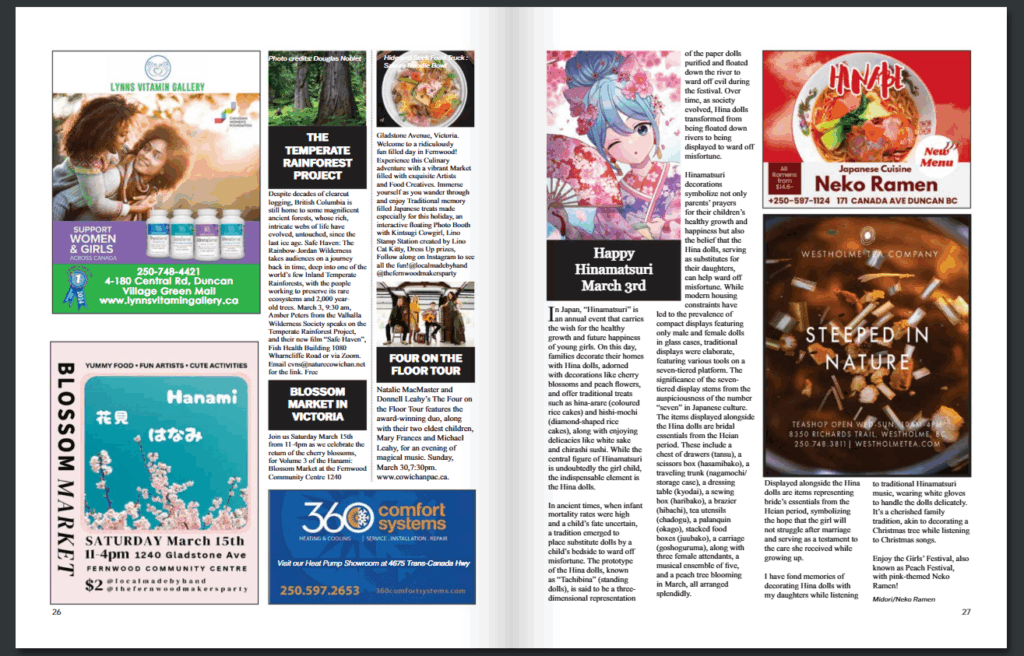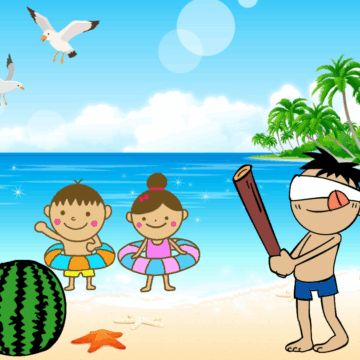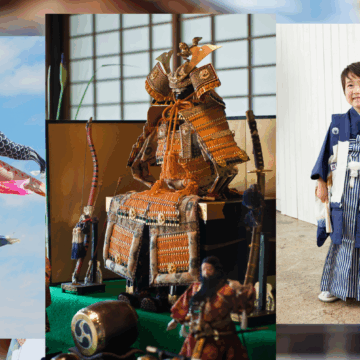In Japan, “Hinamatsuri” is an annual event that carries the wish for the healthy growth and future happiness of young girls. On this day, families decorate their homes with Hina dolls, adorned with decorations like cherry blossoms and peach flowers, and offer traditional treats such as hina-arare (colored rice cakes) and hishi-mochi (diamond-shaped rice cakes), along with enjoying delicacies like white sake and chirashi sushi. While the central figure of Hinamatsuri is undoubtedly the girl child, the indispensable element is the Hina dolls.
In ancient times, when infant mortality rates were high and a child’s fate uncertain, a tradition emerged to place substitute dolls by a child’s bedside to ward off misfortune. The prototype of the Hina dolls, known as “Tachibina” (standing dolls), is said to be a three-dimensional representation of the paper dolls purified and floated down the river to ward off evil during the festival. Over time, as society evolved, Hina dolls transformed from being floated down rivers to being displayed to ward off misfortune.
Hinamatsuri decorations symbolize not only parents’ prayers for their children’s healthy growth and happiness but also the belief that the Hina dolls, serving as substitutes for their daughters, can help ward off misfortune. While modern housing constraints have led to the prevalence of compact displays featuring only male and female dolls in glass cases, traditional displays were elaborate, featuring various tools on a seven-tiered platform. The significance of the seven-tiered display stems from the auspiciousness of the number “seven” in Japanese culture.
The items displayed alongside the Hina dolls are bridal essentials from the Heian period. These include a chest of drawers (tansu), a scissors box (hasamibako), a traveling trunk (nagamochi/storage case), a dressing table (kyodai), a sewing box (haribako), a brazier (hibachi), tea utensils (chadogu), a palanquin (okago), stacked food boxes (juubako), a carriage (goshoguruma), along with three female attendants, a musical ensemble of five, and a peach tree blooming in March, all arranged splendidly.
Displayed alongside the Hina dolls are items representing bride’s essentials from the Heian period, symbolizing the hope that the girl will not struggle after marriage and serving as a testament to the care she received while growing up.
I have fond memories of decorating Hina dolls with my daughters while listening to traditional Hinamatsuri music, wearing white gloves to handle the dolls delicately. It’s a cherished family tradition, akin to decorating a Christmas tree while listening to Christmas songs.
Enjoy the Girls’ Festival, also known as Peach Festival, with pink-themed Neko Ramen!
Midori/Neko Ramen
This article was contributed to the March 2025 issue of Cowichan Valley Voice.
3月3日は日本のひな祭りです
日本において、「ひな祭り」は女児が健やかに育ち、将来幸せな結婚ができるようにという願いが込められた年中行事です。この日には、ひな人形を飾り、桜や桃の花など木々の飾り、雛あられや菱餅などを供え、白酒やちらし寿司などの飲食を楽しむ祭りとして行われます。特ひな祭りの主人公はもちろん「女の子」ですが、欠かせないものが「ひな人形」です。昔は乳幼児の死亡率が高く、子供が無事に成長できるかどうかは、神のみぞ知る事柄でした。そのため穢れを移す身代わりの人形を子供の枕元へ置いて、災厄を祓う風習がありました。
また、雛人形の原型となった「立ち雛」は厄を祓って水に流した「ひとがた」を立体化したものとも言われています。のちには上巳の節句に子供の穢れや厄を移した雛人形を川へ流す「流し雛」の風習も生まれました。
やがて時代と共に、雛人形は立派で豪華絢爛なものになります。そのため、雛人形を川へ流すのではなく、これを「飾ること」で厄を祓う形へと変化していきました。
すなわち雛飾りには、子供が健やかに育ち幸せな結婚をして欲しいという両親の祈りと同時に雛人形が娘の代わりに身代わりとなって厄を引き受ける効果があると信じられている思いを込めた祭りなのです。
現代は日本の住宅事情に合わせてコンパクトに男雛と女雛だけをガラスケースに収めたものを飾る家も増えていますが、本来は七段の階段状の土台に様々な道具が豪華に飾られていました。七段飾り。その意味は?というと、古くから縁起の良い数字とされていたのが「七」なので、雛人形を飾る壇も七段となっています。雛人形と一緒に飾られているものは、平安時代の頃の嫁入り道具です。箪笥(たんす)・鋏箱(はさみばこ)・長持(ながもち/収納ケース)・鏡台(きょうだい)・針箱(はりばこ)・火鉢(ひばち)・茶道具(ちゃどうぐ)・御駕籠(おかご)・重箱(じゅうばこ)・御所車(ごしょぐるま)と呼ばれる生活に欠かせない道具と3人の女性の召使や、5人組の演奏部隊、そして3月の季節に咲く「桃の木」などを豪華に並べたものです。
様々な手の込んだ調度品は、女の子が結婚をした後に苦労をしないためそして、これほどの豪華なお品を持たせるほど大切に育てた証の意味で飾られているとされています。
私も娘たちと一緒に、日本独自のひな祭り用の音楽を聴きながら、白い手袋をつけてひな人形を丁寧に扱って飾りつけていました。それはクリスマスソングを聞きながらツリーのデコレーションをするのと同じで家族行事の素晴らしい思い出の一つです。
桃の節句とも呼ばれる女の子のお祭り「ひな祭り」を桃色=ピンクのインテリアがテーマの猫ラーメンでお楽しみくださいね。
この記事はCowichan Valley Voice 2025年3月号に寄せた記事/英語です。








